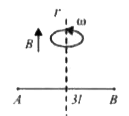A metallic rod of length l is rotated at a constant angular speed , normal to a uniform magnetic field B. Derive an expression for the current induced in the rod, if the resistance of the rod is R.
To derive the expression for the current induced in a metallic rod of length l rotating at a constant angular speed ω in a uniform magnetic field B, we can follow these steps:
Step 1: Understanding the Motion of the Rod
The rod is rotating about one end with an angular speed ω. As it rotates, different points along the length of the rod move with different linear velocities. The linear velocity v of a point at a distance r from the axis of rotation is given by:
v=rω
where r varies from 0 to l (the length of the rod).
Step 2: Induced EMF in the Rod
According to Faraday's law of electromagnetic induction, an electromotive force (EMF) is induced in the rod due to its motion in the magnetic field. The induced EMF (E) can be calculated by considering a small segment dr of the rod at a distance r from the pivot point. The EMF induced in this small segment is given by:
dE=B⋅v⋅dr
Substituting v=rω:
dE=B⋅(rω)⋅dr
Step 3: Total Induced EMF
To find the total EMF induced in the entire rod, we need to integrate this expression from r=0 to r=l:
E=∫l0B⋅(rω)dr
Calculating the integral:
E=Bω∫l0rdr=Bω(r22)l0=Bω⋅l22
Thus, the total induced EMF in the rod is:
E=Bωl22
Step 4: Calculating the Induced Current
The induced current I in the rod can be calculated using Ohm's law, which states that:
I=ER
Substituting the expression for the induced EMF:
I=Bωl22R=Bωl22R
Final Expression
Thus, the expression for the current induced in the rod is:
I=Bωl22R
The rod is rotating about one end with an angular speed ω. As it rotates, different points along the length of the rod move with different linear velocities. The linear velocity v of a point at a distance r from the axis of rotation is given by:
v=rω
where r varies from 0 to l (the length of the rod).
According to Faraday's law of electromagnetic induction, an electromotive force (EMF) is induced in the rod due to its motion in the magnetic field. The induced EMF (E) can be calculated by considering a small segment dr of the rod at a distance r from the pivot point. The EMF induced in this small segment is given by:
dE=B⋅v⋅dr
Substituting v=rω:
dE=B⋅(rω)⋅dr
To find the total EMF induced in the entire rod, we need to integrate this expression from r=0 to r=l:
E=∫l0B⋅(rω)dr
Calculating the integral:
E=Bω∫l0rdr=Bω(r22)l0=Bω⋅l22
Thus, the total induced EMF in the rod is:
E=Bωl22
The induced current I in the rod can be calculated using Ohm's law, which states that:
I=ER
Substituting the expression for the induced EMF:
I=Bωl22R=Bωl22R
Thus, the expression for the current induced in the rod is:
I=Bωl22R
Topper's Solved these Questions
Similar Questions
A coil of number of turns N, area A, is rotated at a constant angular speed ω, in a uniform magnetic field B, and connected to a resistor R. Deduce expressions for :
(i) maximum emf induced in the coil, (ii) power dissipated in the coil.
View SolutionA conducting rod of length l is rotating with constant angular velocity ω about point O in a uniform magnetic field B as shown in the figure . What is the emf induced between ends P and Q ?

View Solution
Knowledge Check
A metallic rod of length L rotates at an angular speed ω, normal to a uniform magnetic field. If the resitance of rod is R the heat dissipated is:
A14B2L4ω2tRB12B2L2ωtRC14B2L2ω2t2RD14BL2ω4tRA copper rod of length L rotates with an angular with an angular speed 'ω' in a uniform magnetic field B. find the emf developed between the two ends of the rod. The field in perpendicular to the motion of the rod.
ABωl2B12Bωl2C2Bωl2D14Bωl2A copper rod AB of length L, pivoted at one end A, rotates at constant angular velocity omega, at right angles to a uniform magnetic field of induction B. The e.m.f developed between the mid point C of the rod and B is
 ABωl24BBωl22C3Bωl24D3Bωl28
ABωl24BBωl22C3Bωl24D3Bωl28
A copper rod of length L rotates with an angular with an angular speed 'ω' in a uniform magnetic field B. find the emf developed between the two ends of the rod. The field in perpendicular to the motion of the rod.
View SolutionA copper rod of length l rotates an angular velocity ω in a uniform magnetic field B as show in figure . What is the induced emf across its ends ?

View Solution(a) A metal rod of length L rotates about an end with a uniform angular velocity ω . A uniform magnetic field B exists in the direction of the axis of rotation. Calculate the emf induced between the ends of the rod. Neglect the centripetal force acting on the free electrons as they move in circular paths.
(b) A rod of length L rotates with a small but uniform angular velocity ω about its perpendicular bisector. A uniform magnetic field B exists parallel to the axis of rotation. Find the potential difference (i) between the centre of rod and one end and (ii) between the two ends of the rod.
View SolutionA conducting rod of length 2l is rotating with constant angular speed ω about is perpendicular bisector. A uniform magnetic field →B exists parallel to the axis of rotation. The e.m.f. induced between two ends of the rod is

View SolutionA conducting rod of length 2l is rotating with constant angular speed w about its perpendicular bisector. A uniform magnetic field B exists parallel to the axis of rotation. The e.m.f. induced between two ends of the rod is

View Solution

